Troy-Bilt TB360BV User Manual

Operator’s Manual
TABLE OF CONTENTS
Service Information . . . . . . . . . . . . . . . . . . . . . . . . . . . . . .1 Rules for Safe Operation . . . . . . . . . . . . . . . . . . . . . . . . . .2 Know Your Unit . . . . . . . . . . . . . . . . . . . . . . . . . . . . . . . . .4 Assembly Instructions . . . . . . . . . . . . . . . . . . . . . . . . . . . .5 Oil and Fuel Information . . . . . . . . . . . . . . . . . . . . . . . . . . .7 Starting/Stopping Instructions . . . . . . . . . . . . . . . . . . . . . .8 Operating Instructions . . . . . . . . . . . . . . . . . . . . . . . . . . . .9 Maintenance and Repair Instructions . . . . . . . . . . . . . . .11 Cleaning and Storage . . . . . . . . . . . . . . . . . . . . . . . . . . .14 Troubleshooting Chart . . . . . . . . . . . . . . . . . . . . . . . . . . .15 Specifications . . . . . . . . . . . . . . . . . . . . . . . . . . . . . . . . .15 Warranty Information . . . . . . . . . . . . . . . . . . . . . . . . . . . .16 Parts List . . . . . . . . . . . . . . . . . . . . . . . . . . . . . . . . . . . .E19
WARNING: When using the unit, you must follow the safety rules. Please read these instructions before operating the unit in order to ensure the safety of the operator and any bystanders. Please keep these instructions for later use.
4-Cycle Gas Blower/Vacuum
TB360BV
SAVE THESE INSTRUCTIONS
For service call 1-800-828-5500 in the United States, or 1-800-668-1238 in Canada to obtain a list of authorized service dealers near you. For more details about your unit, visit our website at www.troybilt.com.
DO NOT RETURN THE UNIT TO THE RETAILER. PROOF OF PURCHASE WILL BE REQUIRED FOR WARRANTY SERVICE.
THIS PRODUCT IS COVERED BY ONE OR MORE U.S. PATENTS. OTHER PATENTS PENDING.
Service on this unit both within and after the warranty period should be performed only by an authorized and approved service dealer.
SPARK ARRESTOR NOTE
NOTE: For users on U.S. Forest Land and in the states of California, Maine, Oregon and Washington. All U.S. Forest Land and the state of California (Public Resources Codes 4442 and 4443), Oregon and Washington require, by law that certain internal combustion engines operated on forest brush and/or grass-covered areas be equipped with a spark arrestor, maintained in effective working order, or the engine be constructed, equipped and maintained for the prevention of fire. Check with your state or local authorities for regulations pertaining to these requirements. Failure to follow these requirements could subject you to liability or a fine. This unit is factory equipped with a spark arrestor. If it requires replacement, ask your LOCAL SERVICE DEALER to install the
Accessory Part #753-052917 Spark Arrestor Kit.
CALIFORNIA PROPOSITION 65 WARNING
WARNING
THE ENGINE EXHAUST FROM THIS PRODUCT CONTAINS CHEMICALS KNOWN TO THE STATE OF CALIFORNIA TO CAUSE CANCER, BIRTH DEFECTS OR OTHER REPRODUCTIVE HARM.
All information, illustrations, and specifications in this manual are based on the latest product information available at the time of printing. We reserve the right to make changes at any time without notice.
Copyright© 2007 MTD SOUTHWEST INC, All Rights Reserved.
P/N 769-03048 |
(03/07) |
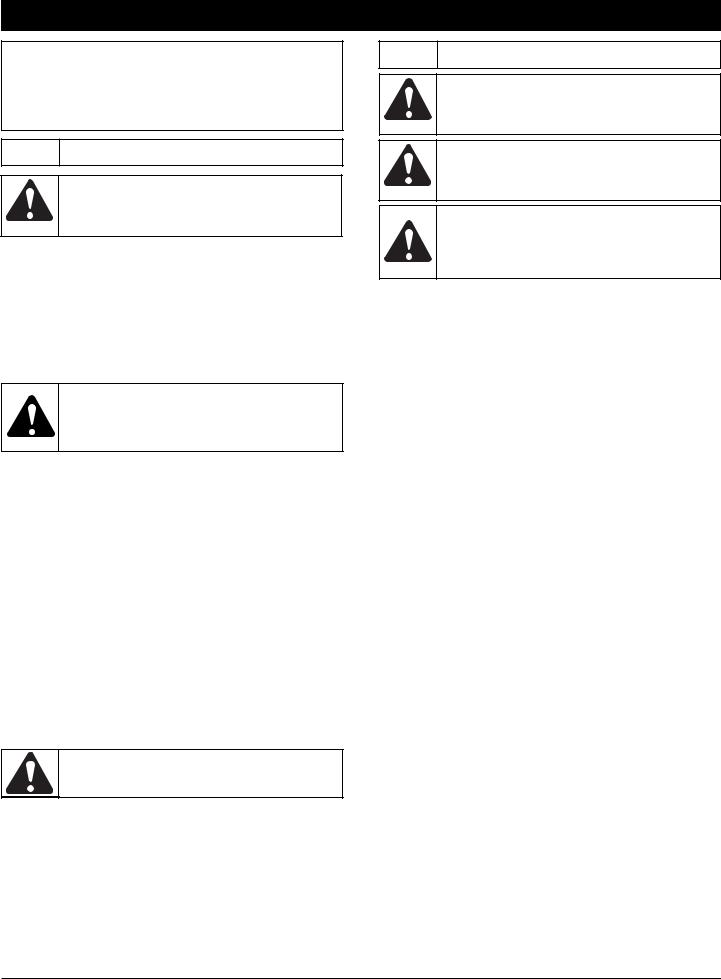
RULES FOR SAFE OPERATION
The purpose of safety symbols is to attract your attention to possible dangers. The safety symbols, and their explanations, deserve your careful attention and understanding. The safety warnings do not by themselves eliminate any danger. The instructions or warnings they give are not substitutes for proper accident prevention measures.
SYMBOL MEANING
SAFETY ALERT: Indicates danger, warning or caution. Attention is required in order to avoid serious personal injury. May be used in conjunction with other symbols or pictographs.
Read the Operator’s Manual(s) and follow all warnings and safety instructions.
Failure to do so can result in serious injury to the operator and/or bystanders.
SYMBOL MEANING
DANGER: Failure to obey a safety warning will result in serious injury to yourself or to others. Always follow the safety precautions to reduce the risk of fire, electric shock and personal injury.
WARNING: Failure to obey a safety warning can result in injury to yourself and others. Always follow the safety precautions to reduce the risk of fire, electric shock and personal injury.
|
CAUTION: Failure to obey a safety warning |
|
may result in property damage or personal injury to |
|
yourself or to others. Always follow the safety |
|
precautions to reduce the risk of fire, electric shock |
|
and personal injury. |
NOTE: |
Advises you of information or instructions vital to the |
FOR QUESTIONS, CALL 1-800-800-7310 |
operation or maintenance of the equipment. |
• IMPORTANT SAFETY INSTRUCTIONS •
READ ALL INSTRUCTIONS BEFORE OPERATING
WARNING: When using the unit, you must follow the safety rules. Please read these instructions before operating the unit in order to ensure the safety of the operator and any bystanders. Please keep these instructions for later use.
•Read the instructions carefully. Be familiar with the controls and proper use of the unit.
•Do not operate this unit when tired, ill, or under the influence of alcohol, drugs, or medication.
•Children and teens under the age of 15 must not use the unit, except for teens guided by an adult.
•All guards and safety attachments must be installed properly before operating the unit.
•Inspect the unit before use. Replace damaged parts. Check for fuel leaks. Make sure all fasteners are in place and secure. Replace parts that are cracked, chipped, or damaged in any way. Do not operate the unit with loose or damaged parts.
•Carefully inspect the area before starting the unit. Remove all debris and hard or sharp objects such as glass, wire, etc.
•Clear the area of children, bystanders, and pets. At a minimum, keep all children, bystanders, and pets outside a 50 feet (15 m.) radius; there still may be a risk to bystanders from thrown objects. Bystanders should be encouraged to wear eye protection. If you are approached, stop the unit immediately.
SAFETY WARNINGS FOR GAS UNITS
•Store fuel only in containers specifically designed and approved for the storage of such materials.
WARNING: Gasoline is highly flammable, and its vapors can explode if ignited. Take the following precautions:
•Avoid creating a source of ignition for spilled fuel. Do not start the engine until fuel vapors dissipate.
•Always stop the engine and allow it to cool before filling the fuel tank. Never remove the cap of the fuel tank, or add fuel, when the engine is hot. Never operate the unit without the fuel cap securely in place. Loosen the fuel tank cap slowly to relieve any pressure in the tank.
•Add fuel in a clean, well-ventilated outdoor area where there are no sparks or flames. Slowly remove the fuel cap only after stop-ping engine. Do not smoke while adding fuel. Wipe up any spilled fuel from the unit immediately. Always wipe unit dry before using.
•Move the unit at least 30 feet (9.1 m) from the fueling source and site before starting the engine. Do not smoke or allow sparks and open flames near the area while adding fuel or operating the unit.
WHILE OPERATING
•Never start or run the unit inside a closed room or building. Breathing exhaust fumes can kill. Operate this unit only in a well-ventilated outdoor area.
•To reduce the risk of injury associated with thrown objects, wear safety glasses or goggles that are marked as meeting ANSI Z87. standards.
•Never run the unit without the the proper equipment attached. When using this unit, always install the blower/vacuum tubes and vacuum bag depending on model. Make sure the vacuum bag is completely zipped closed.
•To reduce the risk of hearing loss associated with sound level(s), always wear ear/hearing protection when operating this unit.
•Wear heavy, long pants, boots, and gloves. Do not wear short pants, sandals, or go barefoot.
•To avoid static electricity shock, do not wear rubber gloves or any other insulated gloves while operating this unit.
•To reduce the risk of injury associated with objects being drawn into rotating parts, do not wear loose clothing, jewelry, scarves, and the like. Secure hair above shoulder level.
•Wear a face or dust mask if the operation is dusty. Long sleeve shirts are recommended.
•Use the unit only in daylight or good artificial light.
•Keep outside surfaces free from oil and fuel.
•Avoid accidental starting. Be in the starting position whenever pulling the starter rope. The operator and unit must be in a stable position while starting. Refer to Starting/Stopping Instructions.
•Do not set unit on any surface except a clean, hard area while engine is running. Debris such as gravel, sand, dust, grass, etc. could be picked up by the air intake and thrown out by the discharge opening, damaging unit, property, or causing serious injury to bystanders or operator.
•Use the right tool. Only use this tool for the purpose intended.
•Do not force unit. It will do the job better and with less likelihood of injury at a rate for which it was designed.
•Do not overreach or use from unstable surfaces such as ladders, trees, steep slopes, rooftops, etc. Always keep proper footing and balance.
•Always hold the unit with a firm grip when operating.
•Keep hands, face, and feet at a distance from all moving parts. Do not touch or try to stop the impeller when it is rotating. Do not operate without guards in place.
2
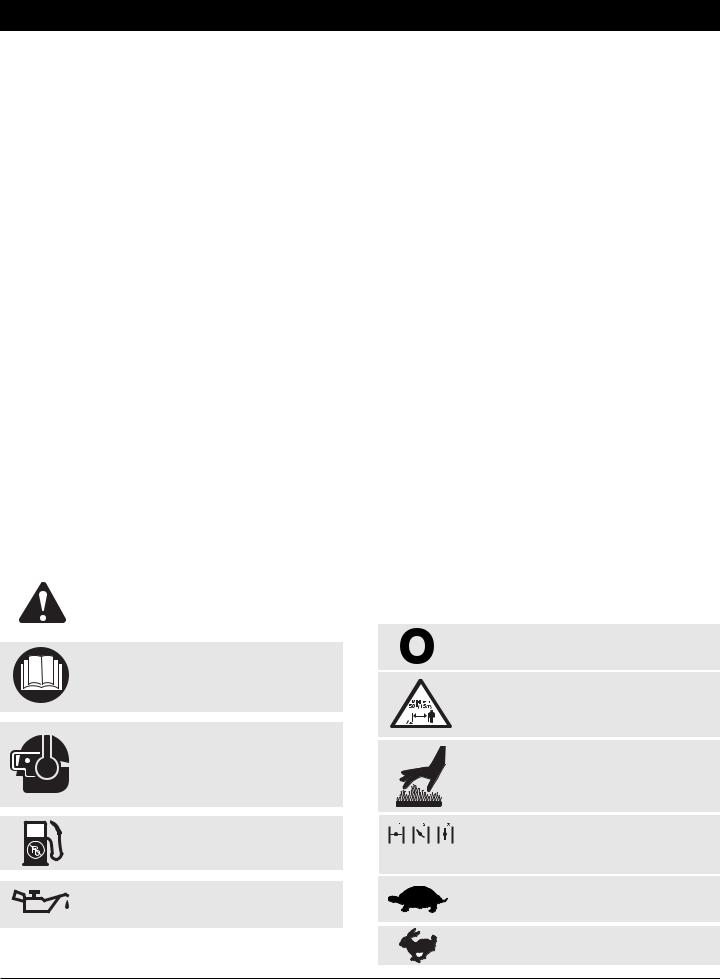
RULES FOR SAFE OPERATION
•Do not put any object into openings. Do not use with any opening blocked; keep free of dirt, debris, and anything that may reduce the air flow.
•Do not touch the engine or muffler. These parts get extremely hot from operation. When turned off they remain hot for a short time.
•Do not operate the engine faster than the speed needed to do the job. Do not run the engine at high speed when not in use.
•Always stop the engine when operation is delayed or when walking from one location to another.
•Stop the engine for maintenance, repair, to install or remove the blower tubes or vacuum attachments. The unit must be stopped and the impeller no longer turning to avoid contact with the rotating blades.
•Use only original equipment manufacturer replacement parts when servicing this unit. These parts are available from your authorized service dealer. Do not use unauthorized parts, accessories, or attachments for this unit. Doing so could lead to serious injury to the user, or damage to the unit, and void your warranty.
•Never use this unit for spreading chemicals, fertilizers or other substances which may contain toxic materials.
•To reduce fire hazard, replace faulty muffler and spark arrestor, keep the engine and muffler free from grass, leaves, excessive grease or carbon build up.
WHILE OPERATING UNIT AS A BLOWER
•Never point the blower in the direction of people or pets, or in the direction of windows. Always direct the blowing debris away from people, animals, and windows. Use extra caution when blowing debris near solid objects such as trees, automobiles, walls, etc.
WHILE OPERATING UNIT AS A VACUUM
•Avoid situations that could catch the vacuum bag on fire. Do not operate near an open flame. Do not vacuum warm ash from fire-places, barbecue pits, brush piles, etc. Do not vacuum discarded cigars or cigarettes unless the cinders are completely cool.
•The unit is designed to pickup dry material such as leaves, grass, small twigs, and bits of paper. Do not attempt to vacuum wet debris and/or standing water as this may result in damage to the blower/ vacuum. To avoid severe damage to the impeller, do not vacuum metal, broken glass, etc.
OTHER SAFETY WARNINGS
•Always disconnect the spark plug before performing maintenance or accessing movable parts.
•Never store the unit, with fuel in the tank, inside a building where fumes may reach an open flame (pilot lights, etc.) or sparks (switches, electrical motors, etc.).
•Allow the engine to cool before storing or transporting. Be sure to secure the unit while transporting.
•Store the unit in a dry place, either locked up or up high to prevent unauthorized use or damage. Keep out of the reach of children.
•Never douse or squirt the unit with water or any other liquid. Keep handles dry, clean, and free from debris. Clean after each use, see Cleaning and Storage instructions.
•Keep these instructions. Refer to them often and use them to instruct other users. If you loan this unit to others, also loan these instructions to them.
SPECIAL NOTE: Exposure to vibrations through prolonged use of gasoline powered hand tools could cause blood vessel or nerve damage in the fingers, hands, and joints of people prone to circulation disorders or abnormal swelling. Prolonged use in cold weather has been linked to blood vessel damage in otherwise healthy people. If symptoms occur such as numbness, pain, loss of strength, change in skin color or texture, or loss of feeling in the fingers, hands or joints, discontinue use of this tool and seek medical attention. An anti-vibration system does not guarantee avoidance of these problems. Users who operate power tools on a regular basis must closely monitor their physical condition and the condition of this tool.
SAVE THESE INSTRUCTIONS
• SAFETY AND INTERNATIONAL SYMBOLS •
This operator's manual describes safety and international symbols and pictographs that may appear on this product. Read the operator's manual for complete safety, assembly, operating and maintenance and repair information.
SYMBOL |
MEANING |
SYMBOL |
MEANING |
|||
|
• SAFETY ALERT SYMBOL |
|
|
|
|
• ON/OFF STOP CONTROL |
|
|
|
|
|
||
|
Indicates danger, warning or caution. May be |
|
|
|
|
ON / START / RUN |
|
used in conjunction with other symbols or |
|
|
|
|
|
|
pictographs. |
|
|
|
|
|
|
|
|
|
• ON/OFF STOP CONTROL |
||
|
|
|
|
|
|
|
•WARNING - READ OPERATOR'S MANUAL
Read the operator’s manual(s) and follow all warnings and safety instructions. Failure to do so can result in serious injury to the operator and/or bystanders.
•WEAR EYE AND HEARING PROTECTION
WARNING: Thrown objects and loud noise can cause severe eye injury and hearing loss. Wear eye protection meeting ANSI Z87.1 standards and ear protection when operating this unit. Use a full face shield when needed.
•UNLEADED FUEL
Always use clean, fresh unleaded fuel
OFF or STOP
•KEEP BYSTANDERS AWAY
WARNING: Keep all bystanders, especially children and pets, at least 50 feet (15 m) from the operating area.
•HOT SURFACE WARNING
Do not touch a hot muffler, gear housing or cylinder. You may get burned. These parts get extremely hot from operation. They remain hot for a short time after the unit is turned off.
•CHOKE CONTROL
1.• FULL choke position
2.• PARTIAL choke position
3.• RUN choke position
•OIL
Refer to operator’s manual for the proper type of oil.
•THROTTLE CONTROL
Indicates “IDLE,” “LOW,” or “SLOWEST” speed
•THROTTLE CONTROL
Indicates “HIGH” or “FASTEST” speed
3
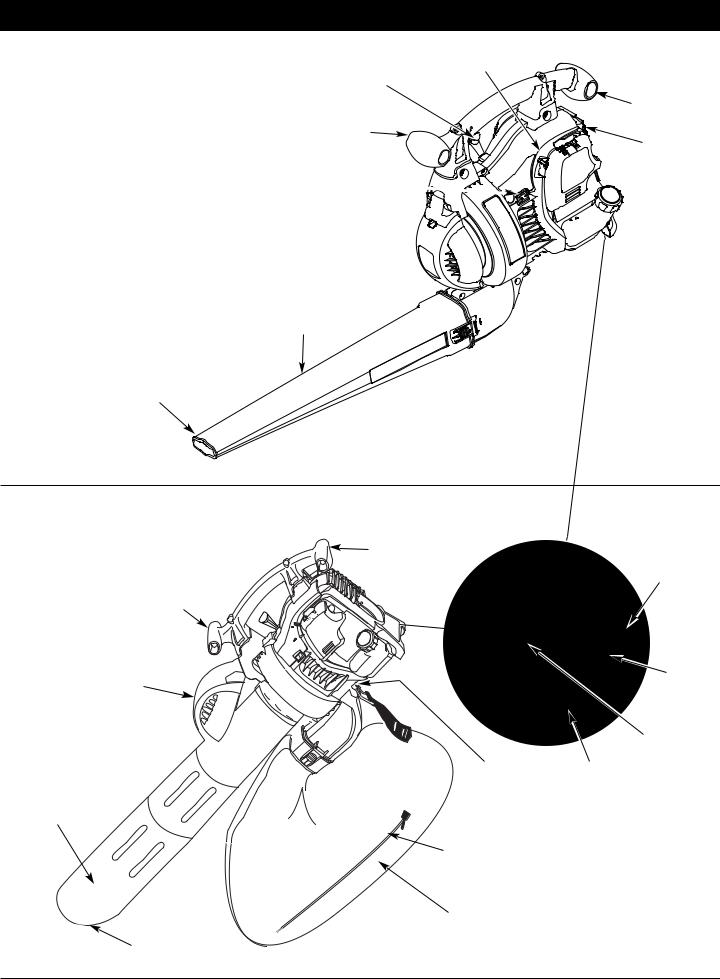
APPLICATIONS
As a blower:
•Cleaning yards, garages, driveways, porches, patios, around walls, fences and more
As a vacuum:
• Picking up leaves and other light debris
KNOW YOUR BLOWER/VAC
Throttle Control
Starter Rope
Grip
Rear Handle
Front Handle
Spark Plug
On/Off Stop
Control 
 Fuel
Fuel
Cap
Assembled as a Blower
Blower Tube
Blower
Outlet
Assembled as a Vacuum |
Rear Handle |
Air filter/muffler |
|
|
cover |
Front Handle |
|
Vacuum |
Muffler |
Door |
|
|
Primer |
|
Bulb |
Vacuum |
Oil Plug |
Bag Hook |
|
Vacuum
Tube
Vacuum Bag
Zipper
Vacuum Bag
Vacuum Inlet
4
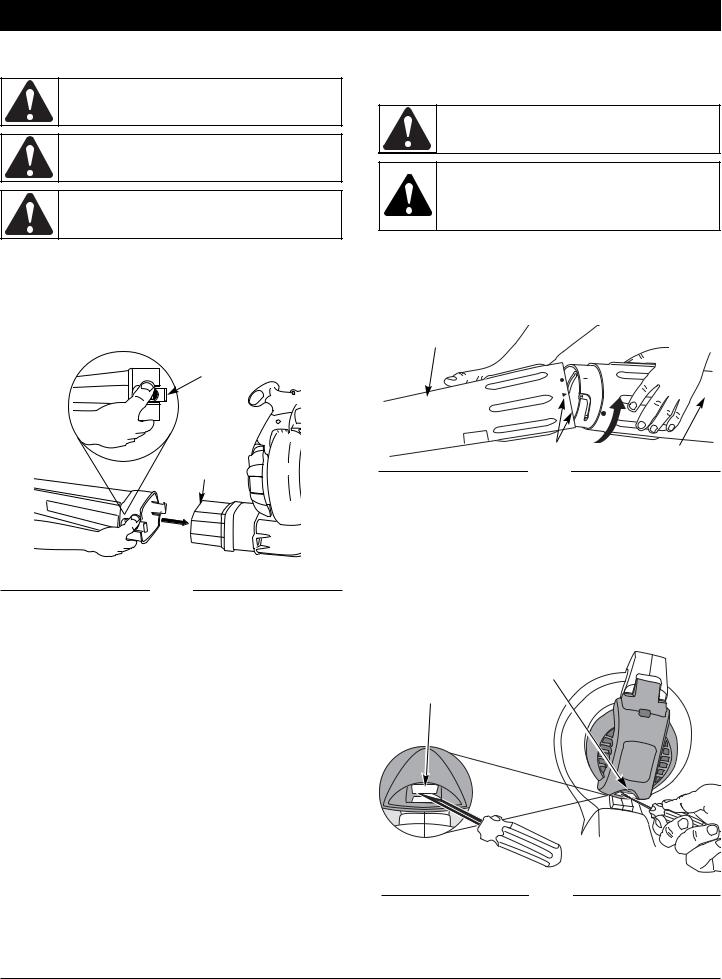
ASSEMBLY INSTRUCTIONS
ASSEMBLING UNIT AS A BLOWER
Blower Tube Assembly
WARNING: To prevent serious personal injury, stop the engine and allow the impeller to stop before attaching or removing tubes.
WARNING: To prevent serious personal injury or damage to the unit, the blower tube must be installed while operating this unit as a blower.
WARNING: Never operate the unit in the blower configuration without the vacuum door secured and latched shut.
NOTE: If the unit was assembled as a vacuum unit, remove all vacuum parts and store away in a secure place for later use.
Installing
•Install the blower tube over the blower outlet and push it on until both tabs snap into place (Fig. 1).
ASSEMBLING UNIT AS A VACUUM
To assemble the unit as a vacuum, begin by removing the blower tube. Refer to the previous section.
Vacuum Tube Assembly
WARNING: To prevent serious personal injury, stop the engine and allow the impeller to stop before attaching or removing tubes.
WARNING: To prevent serious personal injury or |
damage to the unit, always install vacuum tubes and |
the vacuum bag, and make sure the vacuum bag is |
completely zipped closed when operating this unit |
as a vacuum. |
NOTE: If the unit was assembled as a blower unit, remove the |
blower tube and store away in a secure place for later use.
Installation
1.Align the small arrow on the lower vacuum tube with the arrow on the upper vacuum tube (Fig. 2).
Lower Vac Tube
Tabs
Blower
Outlet
Fig. 1
Removing
•Remove the blower tube by pressing both tabs at the same time and pulling off the blower (Fig. 1).
Arrows |
Upper Vac Tube |
|
|
Fig.2 |
|
2.Grasp the lower and upper vacuum tubes firmly with both hands, and push the lower vacuum tube into the upper vacuum tube. Turn the lower vacuum tube clockwise until it snaps into place and locks. When properly assembled, the dot on the lower tube aligns with the dot on the upper tube.
3.Flip the blower/vac so it is standing straight up on the muffler cover. The front of the unit and the vacuum door should face you.
4.Insert a flat head screwdriver under locking clip, lift upward and open vacuum door (Fig. 3).
Vacuum
Door Slot
Locking
Clip
Fig. 3
5

ASSEMBLY INSTRUCTIONS
5.While holding the vacuum door open, insert the assembled vacuum tube (put together in Step 2). Arrange the tube so the flat area faces the vacuum door. The grooves on the side of the tube will line up with the small tabs in the impeller intake (Fig. 4). From the exterior, align the small arrow on the vacuum tube with the arrow on the impeller intake.
Vacuum Tube |
Flat |
Groove |
Area |
Tabs
 Arrows
Arrows
Impeller Intake
Fig. 4
6.Push the vacuum tube in firmly and grip it with both hands. Turn the tube clockwise as far as possible until it snaps into place and locks. When properly assembled, the dot on the vacuum tube will align with the dot on the impeller intake.
Bag
bag adapter over the blower outlet and tabs snap into place (Fig. 5). Position below the unit.
Tabs
Vacuum Bag Hook
Fig. 5
8.Attach the vacuum bag to the vacuum bag hook located at the underside of the unit.
9.Keep the bag zipped and shut.
Removing the Vacuum Bag
1.Unhook the bag.
2.Remove the vacuum bag by pressing both tabs on the vacuum bag elbow at the same time and pulling the bag off the blower (Fig. 5).
3.Install the blower tube in order to assemble the unit as a blower.
4.Make sure the vacuum door is securely latched shut.
WARNING: Never operate the unit in the blower configuration without the vacuum door secured and latched shut.
Emptying the Vacuum Bag
1.Refer to Emptying the Vacuum Bag in Operating Instructions.
INSTALLING THE SHOULDER STRAP
WARNING: To avoid serious personal injury, never attempt to start the unit when standing with the unit clipped to the shoulder strap. Always follow the starting procedures as described in the
Starting/ Stopping Instructions section.
1.Push the strap through the center of the buckle.
2.Pull the strap over the cross bar and down through the slot in the buckle (Fig.6).
Clip
Fig. 6
3.Snap the clip on to the support fittings on the front or back of the handle. Clip to the front portion of the handle when using the unit as a blower, and clip to the back portion of the handle when using the unit as a vacuum (Fig. 7).
Attach Here for |
Attach Here for |
Blowing |
Vacuuming |
Fig. 7
4.While standing in the operating position, adjust the length to fit the operator’s size. Pull the tab to lengthen, pull the strap to shorten (Fig 8).
Fig. 8
6
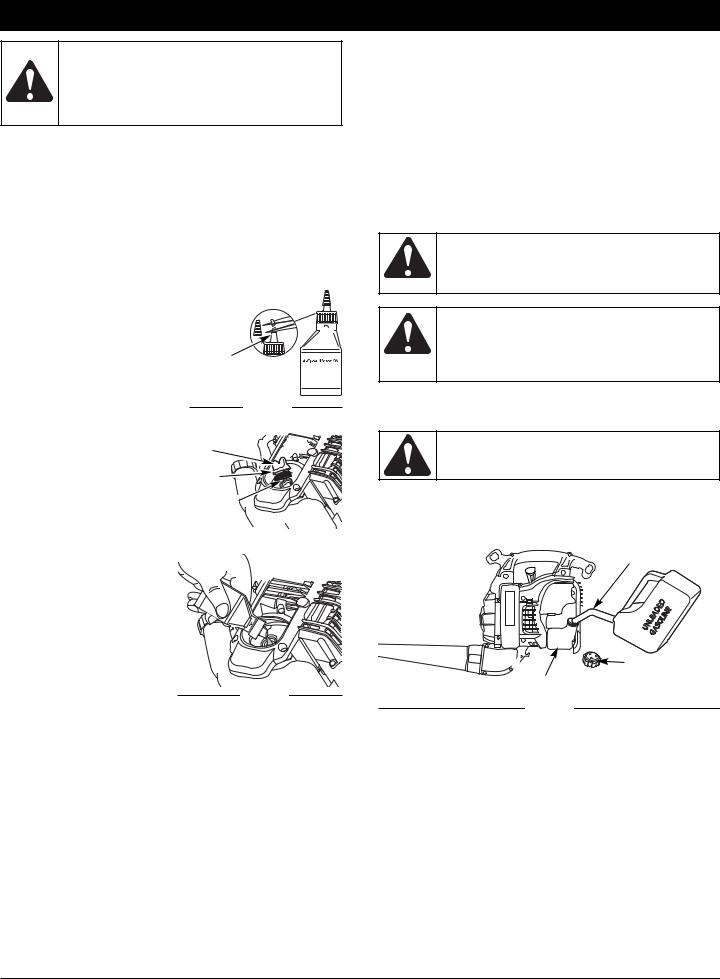
OIL AND FUEL INFORMATION
WARNING: OVERFILLING OIL CRANKCASE MAY CAUSE SERIOUS PERSONAL INJURY. Check and maintain the proper oil level in the crank case; it is important and cannot be overemphasized. Check the oil before each use and change it as needed.
See Changing the Oil.
Using Blended Fuels
If you choose to use a blended fuel, or its use is unavoidable, follow recommended precautions:
•Always use fresh unleaded gasoline
•Use a gas stabilizer fuel additive
•Drain tank and run the engine dry before storing unit
RECOMMENDED OIL TYPE
Using the proper type and weight of oil in the crankcase is extremely important. Check the oil before each use and change the oil regularly. Failure to use the correct oil, or using dirty oil, can cause premature engine wear and failure.
Use a high-quality SAE 30 weight oil of API (American Petroleum Institute) service class SF, SG, SH.
Using Fuel Additives
The use of a gas stabilizer will inhibit corrosion and minimize the formation of gum deposits. Using a fuel additive can keep fuel from forming harmful deposits in the carburetor for up to six (6) months. Add 0.8 oz. (23 ml.) of fuel additive per gallon of fuel according to the instructions on the container. NEVER add fuel additives directly to the unit's gas tank.
ADDING OIL TO CRANKCASE: INITIAL USE
NOTE: This unit is shipped without oil. In order to avoid damage to the unit, put oil in the crankcase before you attempt to start the unit.
Your unit is supplied with one 3.04 fluid oz. (90 ml.) bottle of SAE 30 SF, SG, SH oil (Fig. 9).
NOTE: Save the empty oil bottle. It can be used to measure Funnel
the correct amount during Spout future oil changes. See
Changing the Oil.
Fig. 9
1.Unscrew the top of the bottle of oil and remove the paper
seal covering the opening. Oil Fill Plug
Replace the top. Next, cut |
|
|
the tip off the funnel spout |
O-Ring |
|
(Fig. 9). |
||
|
||
2. Tip unit so that the back of Oil Fill Hole |
||
the engine is facing up in a |
|
|
vertical position. |
Fig. 10 |
|
|
||
3.Remove the oil fill plug from the crankcase (Fig. 10).
4.Pour the entire bottle of oil into the oil fill hole (Fig. 11).
NOTE: Never add oil to the fuel or fuel tank.
5. Wipe up any oil that may have spilled and reinstall the oil fill plug.
Check oil before each use and
change as needed. Refer to Fig. 11 Checking the Oil Level.
RECOMMENDED FUEL TYPE
Old fuel is the primary reason for improper unit performance. Be sure to use fresh, clean, unleaded gasoline.
NOTE: This is a four cycle engine. In order to avoid damage to the unit, do not mix oil with gasoline.
Definition of Blended Fuels
Today's fuels are often a blend of gasoline and oxygenates such as ethanol, methanol or MTBE (ether). Alcohol-blended fuel absorbs water. As little as 1% water in the fuel can form acids when stored. Use fresh fuel (less than 60 days old), when using alcohol-blended fuel.
WARNING: Add fuel in a clean, well ventilated outdoor area. Wipe up any spilled fuel immediately. Avoid creating a source of ignition for spilt fuel. Do not start the engine until fuel vapors dissipate.
WARNING: Gasoline is extremely flammable. Ignited vapors may explode. Always stop the engine and allow it to cool before filling the fuel tank. Do not smoke while filling the tank. Keep sparks and open flames at a distance from the area.
FUELING THE UNIT
1.Remove the fuel cap (Fig. 12).
WARNING: Remove fuel cap slowly to avoid injury from fuel spray. Never operate the unit without the fuel cap securely in place.
2.Place the gas container’s spout into the fill hole on the fuel tank (Fig. 12) and fill the tank.
Gas Can Spout
Fuel Cap
Fuel Tank
Fig. 12
NOTE: Do not overfill the tank.
3.Wipe up any gasoline that may have spilled.
4.Reinstall the fuel cap.
5.Move the unit at least 30 ft. (9.1 m) from the fueling source and site before starting the engine.
NOTE: Dispose of the old gasoline in accordance to Federal, State and Local regulations.
7
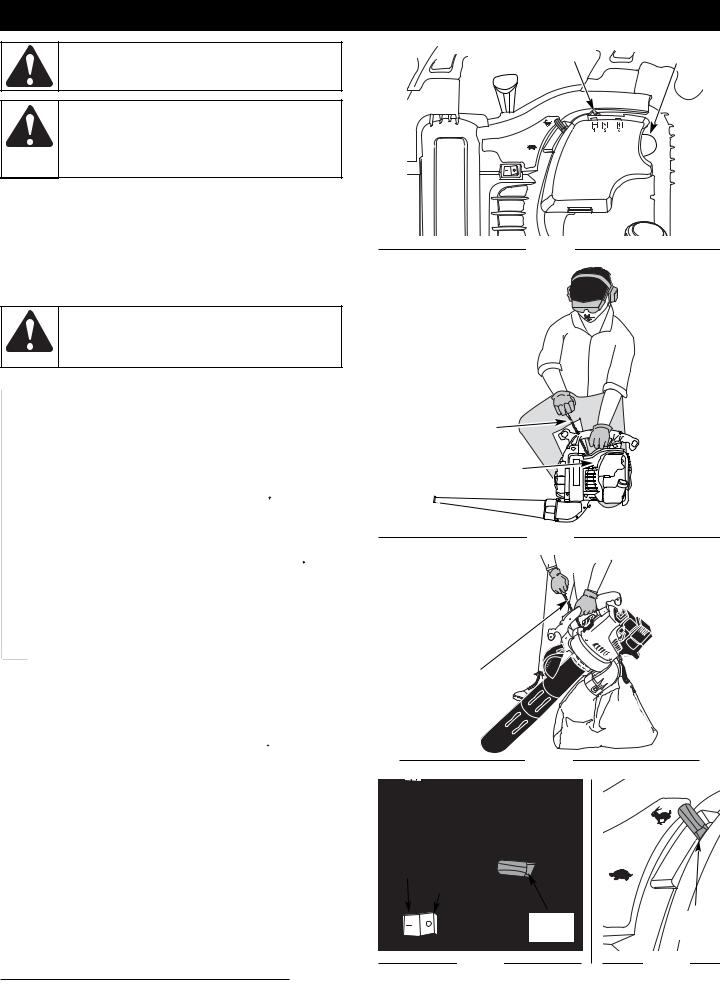
STARTING/STOPPING INSTRUCTIONS
WARNING: Operate this unit only in a wellventilated outdoor area. Carbon monoxide exhaust fumes can be lethal in a confined area.
WARNING: Avoid accidental starting. Make sure you are in the starting position when pulling the starter rope (Fig. 14 or 15). To avoid serious injury, the operator and unit must be in a stable position while starting.
STARTING INSTRUCTIONS
1.Check the oil level in the crankcase. Refer to Checking the Oil Level.
2.Fill the fuel tank with fresh, clean unleaded gasoline. Refer to Fueling the Unit.
NOTE: There is no need to turn the unit on. The On/Off Stop Control is in the ON ( I ) position at all times.
WARNING: To avoid serious personal injury, always remove the vacuum bag prior to refueling the unit. The bag may become a fire hazard when saturated with fuel.

 3. Fully press and release the primer bulb 10 times, slowly. Some amount of fuel should be visible in the primer bulb and fuel lines (Fig. 13). If you can’t see fuel in the bulb, press and release the bulb as many times as it takes before you can see fuel in it.
3. Fully press and release the primer bulb 10 times, slowly. Some amount of fuel should be visible in the primer bulb and fuel lines (Fig. 13). If you can’t see fuel in the bulb, press and release the bulb as many times as it takes before you can see fuel in it.
4.Place the choke lever in Position 1 (Fig. 13).
5.Crouch in the blower starting position (Fig. 14) or
stand in the vacuum starting position (Fig. 15). Move the throttle control to the idle position (  ) (Fig. 16). Pull the starter rope out with a slow and steady motion 5 times.
) (Fig. 16). Pull the starter rope out with a slow and steady motion 5 times.
6.Place the choke lever in Position 2 (Fig. 13).
7.Move the throttle control to the fast position (  ) (Fig. 17) and pull the starter rope out with a slow and steady motion 1 to 4 times to start the engine.
) (Fig. 17) and pull the starter rope out with a slow and steady motion 1 to 4 times to start the engine.
8.Allow the engine to warm up for 15 to 30 seconds.
9.Place the choke lever in Position 3 (Fig. 13). The unit is ready for use.
IF... The engine does not start, go back to step 3.
IF... The engine fails to start after a few attempts, place the choke lever in Position 3. Pull the starter rope out with a slow and steady motion 3 to 8 times—the engine should start. If not, pull 3 to 8 more times.
STOPPING INSTRUCTIONS
1.Move the throttle control to the idle position ( ) (Fig. 16). Allow the engine to cool down by idling.
) (Fig. 16). Allow the engine to cool down by idling.
2.Press and hold On/Off Stop Control in the OFF (O) position until engine comes to a complete stop (Fig. 16)
Choke Lever
Fig. 13
Blower
Starting
Position
Starter Rope
Throttle Control
Fig. 14
Vacuum
Starting
Position
Starter
Rope
Fig. 15
Start/On (I)
Stop/Off (O)
Throttle
Control
Fig. 16
Primer Bulb
Throttle
Control
Fig. 17
8

OPERATING INSTRUCTIONS
HOLDING THE BLOWER/VACUUM
Before operating the unit, stand in the operating position. Check for the following:
• Operator is wearing proper clothing, such as boots, safety glasses or goggles, ear/hearing protection, gloves, long pants and long sleeve shirt
• If the conditions are dusty, the operator is wearing a dust mask or face mask
WARNING: To avoid serious personal injury, wear goggles or safety glasses at all times when operating this unit. Wear a face mask or dust mask in dusty locations.
• The unit is in good working condition
• The tubes are in place and secure
OPERATING TIPS
WARNING: To prevent serious personal injury or damage to the unit, make sure blower tubes or vacuum tubes and the vacuum bag are in place before you operate the unit.
•Be sure the vacuum bag is zipped closed before operating the unit.
•Assure the unit is not directed at anybody or any loose debris before starting the unit.
• Verify that the unit is in good working condition. the tubes are in place and secure.
• Always hold the unit securely when operating. Keep a firm grip on both the front and rear handles.
• To reduce the risk of hearing loss associated with sound level(s), hearing protection is required.
• Operate power equipment only at reasonable hours— early in the morning or late at night when people might disturbed. Comply with times listed in local ordinances Usual recommendations are 9:00 am to 5:00 pm, through Saturday.
•To reduce noise levels, limit the number of pieces of equipment used at any one time.
•To reduce noise levels, operate power blowers at the possible speed to do the job.
•Check your equipment before operation, especially muffler, air intakes and air filters.
•Use rakes and brooms to loosen debris before blowing
•In dusty conditions, slightly dampen surfaces or use attachment when water is available.
•Conserve water by using power blowers instead of
many lawn and garden applications, including areas such as screens, patios, grills, porches, and gardens.
•Watch out for children, pets, open windows or freshly washed cars, and blow debris safely away.
•Use the full blower nozzle extension so the air stream can work close to the ground.
•Clean up after using blowers and other equipment. Dispose of debris appropriately.
OPERATING AS A BLOWER
1Use the blower for trees, shrubs, flower beds and hard-to- clean areas (Fig. 18).
2.Use the unit around buildings and for other normal cleaning procedures (Fig. 18).
3.Use the blower around walls, overhangs, fences and screens (Fig. 19).
Fig. 18
Fig. 19
9

OPERATING INSTRUCTIONS
OPERATING AS A VACUUM
WARNING: To prevent serious personal injury or damage to the unit, always install vacuum tubes, vacuum bag and make sure the vacuum bag is completely zipped closed when operating this unit as a vacuum.
Check for the following before operating the unit:
•Operator is wearing proper clothing, such as boots, safety glasses or goggles, ear/hearing protection, gloves, long pants and long sleeve shirt
•If the conditions are dusty, operator is equipped with a dust mask or face mask
•The unit is in good working condition-- the vacuum tubes and vacuum bag are in place and secure.
•The vacuum shoulder strap is in place and correctly adjusted.
Operation Procedure
Use the unit for vacuuming up light debris like leaves and paper.
Hold the vacuum, tilting the suction tube slightly (2-4 inches or 50-100 mm above the ground), and use a sweeping action to collect light debris (Fig. 20). The debris will flow into the vacuum bag. Items such as small leaves and small twigs will be mulched as they pass through the fan housing, allowing the vacuum bag to hold more debris.
When the bag is full, suction will noticeably decrease. Turn off the unit and allow the impeller to stop before you unzip the bag. Unzip the bag and empty the contents before continuing. Refer to Emptying the Vacuum Bag.
Emptying the Vacuum Bag
WARNING: To avoid serious personal injury, never unzip the vacuum bag without stopping the unit first.
WARNING: As a vacuum, the unit is designed to pick up dry material such as leaves, grass, small twigs and bits of paper. To avoid serious personal injury, do not attempt to vacuum wet debris and/or standing water as this may result in damage to the blower/ vacuum. To avoid severe damage to the impeller, do not vacuum metal, broken glass or similar items.
WARNING: Avoid situations that could catch the vacuum bag on fire. Do not operate near an open flame. Do not vacuum warm ash from fireplaces, barbecue pits, brush piles, etc. Do not vacuum discarded cigars or cigarettes unless the cinders are completely cool.
WARNING: When the upper and lower vacuum tubes are removed, make sure the vacuum door is snapped closed and secured before using the unit, to avoid injury from the impeller.
1.Remove the bag from the vacuum bag hook.
2.While wearing eye protection and a dust mask, unzip the vacuum bag and empty the contents into a garbage bag or container.
3.Turn the bag inside out after initial emptying and vigorously shake out dust and debris.
4.Zip close and reinstall the vacuum bag.
WARNING: To avoid serious personal injury, turn off the unit and allow the impeller to stop before opening vacuum door or installing or removing vacuum bag.
Fig. 20
10
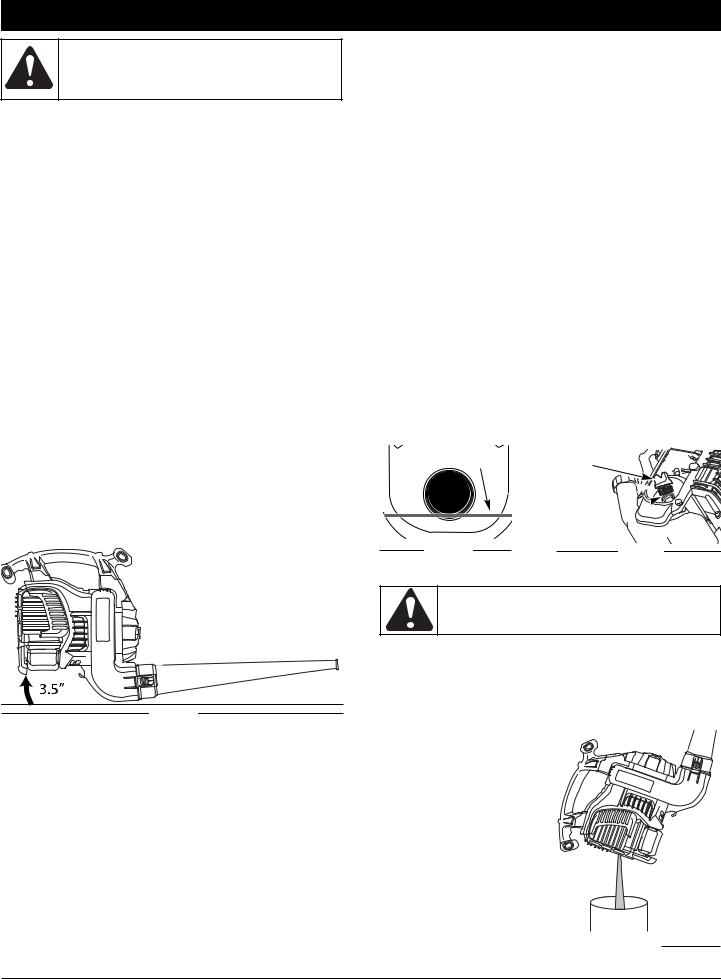
MAINTENANCE AND REPAIR INSTRUCTIONS
WARNING: To prevent serious injury, never perform maintenance or repairs with unit running. Always service and repair a cool unit. Disconnect the spark plug wire to ensure that the unit cannot start.
MAINTENANCE SCHEDULE
Perform these required maintenance procedures at the frequency stated in the table. These procedures should also be a part of any seasonal tune-up.
NOTE: Some maintenance procedures may require special tools or skills. If you are unsure about these procedures take your unit to a qualified service dealer.
NOTE: Maintenance, replacement, or repair of the emission control devices and system may be performed by a qualified service dealer.
In order to assure peak performance of your engine, inspection of the engine exhaust port may be necessary after 50 hours of operation. If you notice lost RPM, poor performance or general lack of acceleration, this service may be required. If you feel your engine is in need of this inspection, refer service to a qualified service dealer for repair. DO NOT attempt to perform this process yourself as engine damage may result from contaminants involved in the cleaning process for the port.
FREQUENCY |
MAINTENANCE REQUIRED |
SEE |
|
|
|
|
|
Before starting engine |
Fill fuel tank with fresh fuel |
p. 7 |
|
Check oil |
p. 11 |
||
|
|||
|
|
|
|
Every 10 hours |
Clean and re-oil air filter |
p. 12 |
|
|
|
|
|
1st change at 10 hours |
Change oil |
p. 11 |
|
2nd change at 25 hours |
Change oil |
p. 11 |
|
Every 25 hours after |
Clean spark arrestor |
p. 14 |
|
|
|
|
|
10 hours on new engine |
Check rocker arm to valve clearance and adjust |
p. 13 |
|
Every 25 hours |
Check rocker arm to valve clearance and adjust |
p. 13 |
|
Every 25 hours |
Check spark plug condition and gap |
p. 14 |
|
|
|
|
CHECKING THE OIL LEVEL
The importance of checking and maintaining the proper oil level in the crankcase cannot be overemphasized. Check oil before each use:
1.Stop the engine and allow oil to drain into the crankcase.
2.Place the engine on a level surface (Fig. 21).
Fig. 21
3.Raise the rear of the unit 3.5 inches to get a proper oil level reading (Fig. 21).
4.Clean the area around the dipstick before removing it. Keep dirt, grass clippings, and other debris out of the engine.
5.Remove the oil fill plug.
6.Look into the oil fill hole (use a flashlight if needed). The oil should be just touching the innermost thread (Fig. 22).
7.If the oil level is not touching the innermost thread on the oil fill hole, add a small amount of oil to the oil fill hole and recheck (Fig. 22). Repeat this procedure until the oil level reaches the innermost thread on the oil fill hole.
NOTE: Do not overfill the unit.
NOTE: Make sure the O-ring is in place on the oil fill plug when checking and changing the oil (Fig. 23).
Max Oil Fill Line |
Oil Fill Plug |
O-Ring 

Oil Fill Hole 
Fig. 22 |
Fig. 23 |
CHANGING THE OIL
WARNING: Wear gloves to prevent injury when handling unit.
For a new engine, change the oil after the first 10 hours of operation. Change the oil while the engine is still warm. The oil will flow freely and carry away more impurities.
1.Unplug spark plug boot to prevent accidental starting.
2.Remove the oil fill plug.
3.Pour the oil out of the oil fill hole and into a container by tipping the unit to a vertical position (Fig. 24). Allow ample time for complete drainage.
4.Wipe up any oil residue on the unit and clean up any oil that may have spilled. Dispose of the oil according to Federal,
State and local regulations.
5. Refill the crankcase with |
|
|
3.04 fluid ounce (90 ml) |
|
|
or 3/8 cup of SAE 30 SF, |
|
Fig. 24 |
|
||
SG, SH oil. |
|
|
|
|
11
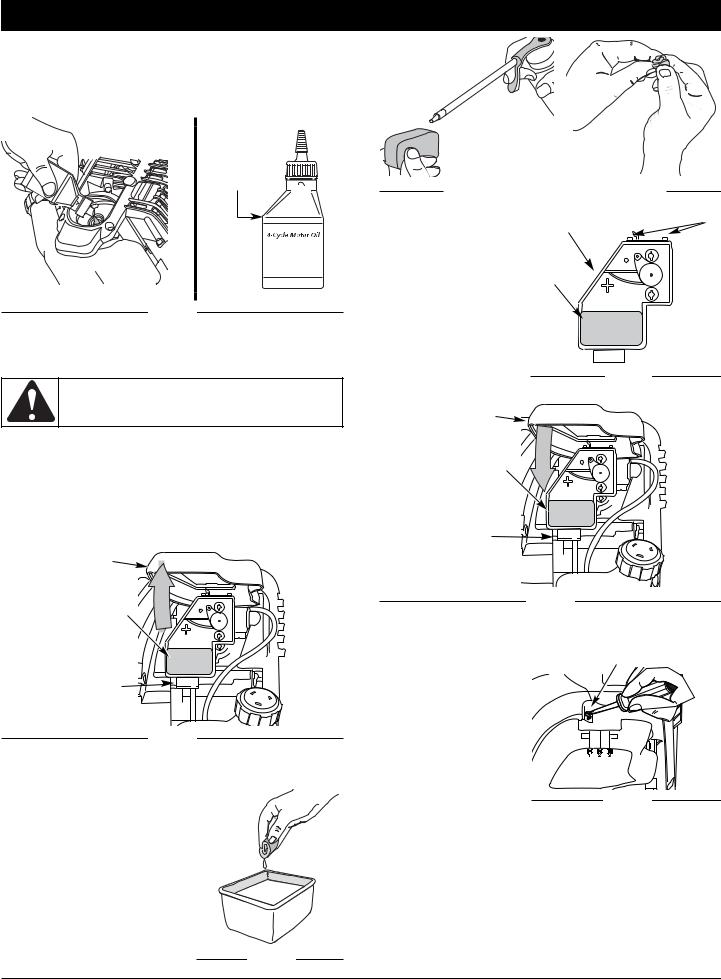
MAINTENANCE AND REPAIR INSTRUCTIONS
NOTE: Use the bottle and spout saved from initial use to measure the correct amount of oil. The top of the label on the bottle measures approximately 3.04 ounces (90 ml) or 3/8 cup (Fig. 25). Check the level, See Checking the Oil Level. If the level is low, add a small amount of oil and recheck. Do not overfill (Fig. 25).
Fill Level
Fig. 25
6.Replace the oil fill plug.
7.Reconnect the spark plug boot.
AIR FILTER MAINTENANCE
WARNING: To avoid serious personal injury, always turn the unit off and allow it to cool before you clean or service it.
Cleaning the Air Filter
Clean and re-oil the air filter every 10 hours of operation. It is an important item to maintain. Failure to maintain your air filter properly can result in poor performance or can cause permanent damage to your engine.
1.Open the air filter cover. Push the tab on the under side of the cover inward. Then pull the air filter cover out and up from the bottom of the cover (Fig. 26).
Air Filter Cover
Air Filter
Tab
Fig. 26
2.Remove the air filter (Fig. 26).
3.Wash the filter in detergent and water (Fig. 27). Rinse the filter thoroughly and allow it to
dry.
4.Apply enough clean SAE 30
motor oil to lightly coat the filter (Fig. 28).
5.Squeeze the filter to spread and
remove excess oil (Fig. 29).
6.Replace the filter (Fig. 26).
NOTE: If the unit is operated without the air filter, you will VOID the warranty.
Fig. 27
Fig. 28 |
|
|
|
Fig. 29 |
|
|
|
7.Reinstall the air filter cover. Position the slots on the top of the air filter cover onto the tabs at the top of the back plate (Fig. 30).
8.Swing the cover down until the tab on the air filter backplate snaps into place in the slot on the air filter cover (Fig. 31).
Air Filter Cover
Air Filter
Tab
Back Plate |
Tabs |
|
|
Air Filter |
|
 Locking Tab
Locking Tab
Fig. 30
Fig. 31
CARBURETOR ADJUSTMENT
The idle speed of the engine is adjustable. An idle adjustment screw is between the air
filter cover and the engine starter housing (Fig. 32).
NOTE: Careless adjustments can seriously damage your unit. A qualified service dealer should make carburetor adjustments.
Check Fuel
Old fuel is usually the
reason for improper unit performance. Drain and refill the tank with fresh fuel prior to making any adjustments. Refer to Oil and Fuel Information.
Clean Air Filter
The condition of the air filter is important to the operation of the unit. A dirty air filter will restrict air flow. This is often mistaken for an out of adjustment carburetor. Check the condition of the air filter before adjusting the idle speed screw.
Refer to Air Filter Maintenance.
12
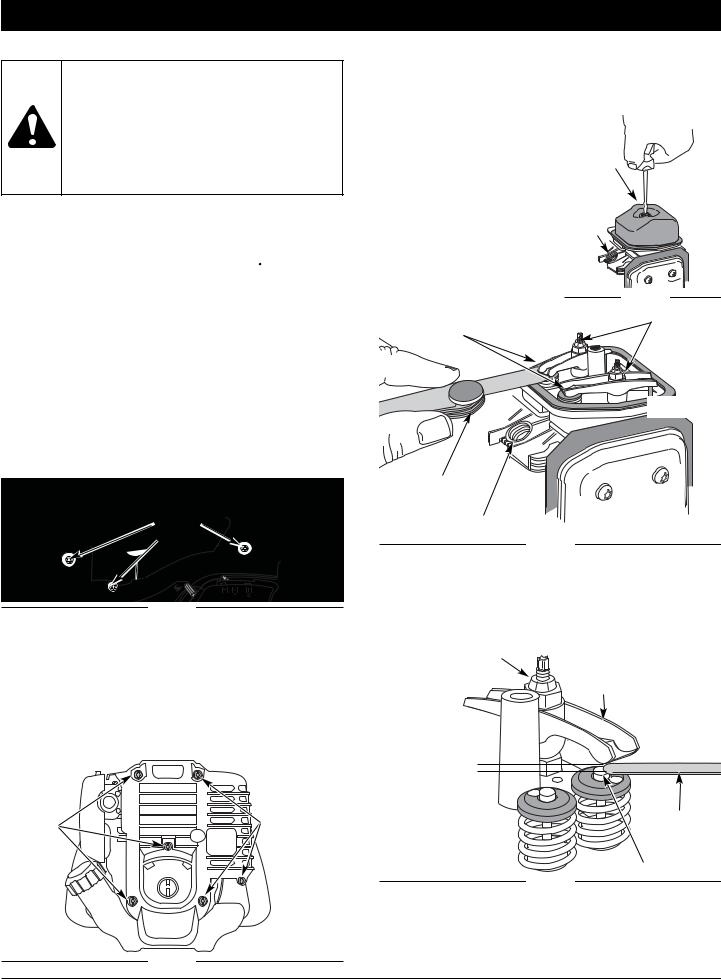
MAINTENANCE AND REPAIR INSTRUCTIONS
Adjust Idle Speed Screw
WARNING: This unit will need to be running during idle speed adjustment. Wear protective clothing and observe all safety instructions to prevent serious personal injury.
Also, DO NOT set unit on any surface except a clean, hard area while starting or performing any adjustments. Debris, such as gravel, sand, dust, grass, etc., could be thrown by the blower tube and damage property or cause serious injury to bystanders or operator.
If, after checking the fuel and cleaning the air filter, the engine still will not idle, adjust the idle speed screw as follows:
1.Start the engine and let it run at a high idle for a minute to warm up. Refer to Starting/Stopping Instructions.
2.Move the throttle control to the idle position (  ) and let the engine idle. If the engine stops, insert a small phillips screwdriver in between the Air Filter Cover and the Engine Cover (Fig. 32). Turn the idle speed screw in, clockwise, 1/8 of a turn at a time (as needed) until the engine idles smoothly.
) and let the engine idle. If the engine stops, insert a small phillips screwdriver in between the Air Filter Cover and the Engine Cover (Fig. 32). Turn the idle speed screw in, clockwise, 1/8 of a turn at a time (as needed) until the engine idles smoothly.
Checking the fuel, cleaning the air filter, and adjusting the idle speed should solve most engine problems. If not and all of the following are true:
•the engine will not idle
•the engine hesitates or stalls on acceleration
•there is a loss of engine power
Have the carburetor adjusted by a qualified service dealer.
ROCKER ARM CLEARANCE
1.Remove the 2 handle screws with flat blade or T20 torx head screwdriver, while holding the nuts with 3/8” nut driver (Fig. 33).
Remove
Screws
Fig. 33
2.Remove top bolt located near starter rope handle with tools mentioned in step 1 (Fig. 33).
3.Loosen screw located near top of door hinge with same tools mentioned in step 1.
4.Open vacuum door, prop open with hand.
5.Remove handle.
6.Remove the six (6) screws on the back of the engine cover with a Flat-head or T-25 Torx screwdriver (Fig. 34).
View Of The Rear Engine Cover
Remove |
Remove |
Screws |
Screws |
Fig. 34
7.Disconnect the spark plug wire.
8.Clean dirt from around the spark plug. Remove the spark plug from the cylinder head by turning a 5/8 in. socket counterclockwise.
9.Remove the engine cover (Fig. 34).
10.Clean dirt from around the
rocker arm cover. Remove |
Rocker |
||
the screw holding the rocker |
Arm |
||
Cover |
|||
arm cover with a large flat |
|||
|
|||
blade screwdriver or Torx T- |
|
||
25 bit (Fig. 35). Remove the |
|
||
rocker arm cover and gasket. Spark |
|||
11. Pull the starter rope slowly to |
Plug |
||
bring the piston to the top of |
Hole |
||
its travel (known as top dead |
|
||
center). Check that: |
|
|
|
• The piston is at the top of |
|
||
its travel while looking in the |
|
||
spark plug hole (Fig. 36). |
Fig. 35 |
||
Rocker Arms |
INTAKE |
Adjusting Nuts |
|
|
|||
|
|
||
EXHAUST
Feeler Gauge
Spark Plug
Hole
Fig. 36
• Both rocker arms move freely, and both valves are closed. If these statements are not true, repeat this step.
12.Slide the feeler gauge between the rocker arm and the valve return spring. Measure the clearance between the valve stem and rocker arm (Fig. 36 & 37). Measure both the intake and exhaust valves.
Adjusting Nut
Rocker Arm
.003–.006 in. (.076–.152 mm)
Feeler Gauge
Valve Stem
Fig. 37
The recommended clearance for both intake and exhaust is .003 – .006 in. (.076 – 0.152 mm). Use a standard automotive .005 in. (0.127 mm) feeler gauge. The feeler gauge should slide between the rocker arm and valve stem with a slight amount of resistance, without binding. See Figures 36 and 37.
13
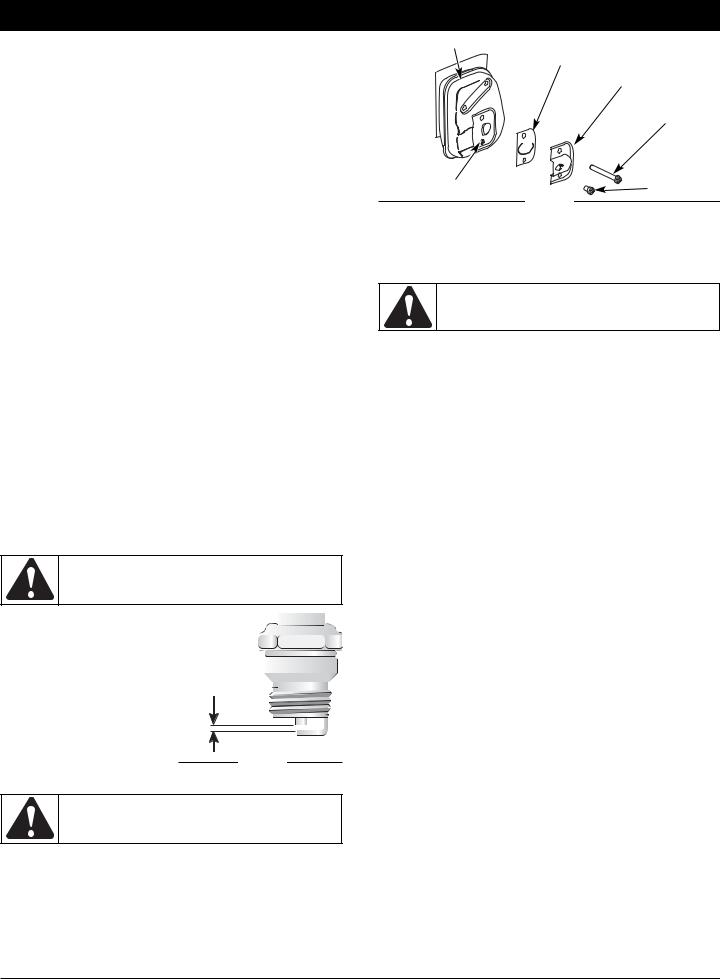
MAINTENANCE AND REPAIR INSTRUCTIONS
13.If the clearance is not within specification:
a.Turn the adjusting nut using a 5/16 inch (8 mm) wrench or nut driver (Fig. 37).
•To increase clearance, turn the adjusting nut counterclockwise.
•To decrease clearance, turn the adjusting nut clockwise.
b.Recheck both clearances, and adjust as necessary.
14.Reinstall the rocker arm cover using a new gasket. Torque the screw to 20–30 in•lb (2.2–3.4 N•m).
15.Check the spark plug and reinstall. See Replacing the Spark Plug.
16.Reinstall the spark plug wire.
17.Reinstall the engine cover. Check alignment of the cover before tightening the screws. Tighten screws.
18.Push rear end of handle into rear screw location.
19.Slide screw through plastic housing and handle. (Do not tighten screw.)
20.Open vacuum door, prop open with hand.
21.Push front end of handle into front screw location.
22.Slide front handle screw through plastic housing. (Do not tighten screw.)
23.Tighten screw near switch and near vacuum door hinge.
24.Tighten handle screws while holding nuts with 3/8” nut driver.
REPLACING THE SPARK PLUG
Use a replacement part number 753-05255 or Champion spark plug, #RDZ19H. The correct spark gap is 0.025 in. (0.635 mm.). Remove the plug after every 25 hours of operation and check its condition.
1.Stop the engine and allow it to cool. Remove the six (6) screws on the back of the engine cover with a Flat-head or T-25 Torx screwdriver (Fig. 31).
2.Grasp the plug wire firmly and pull the cap from the spark plug.
3.Clean dirt from around the spark plug. Remove the spark plug from the cylinder head by turning a 5/8 in. socket counterclockwise.
CAUTION: Do not sand blast, scrape or clean electrodes. Grit in the engine could damage the cylinder.
Muffler
Spark Arrestor Screen
Diverter
T-25 Screw
Slot |
T-20 Screw |
|
Fig. 39
5.Clean the spark arrestor screen with a wire brush or replace it.
6.Reinstall the spark arrestor screen, spark arrestor diverter and screws.
CLEANING
WARNING: To avoid serious personal injury, always turn your unit off and allow it to cool before you clean or service it.
Use a small brush to clean off the outside of the unit. Do not use strong detergents. Household cleaners that contain aromatic oils such as pine and lemon, and solvents such as kerosene, can damage plastic housing or handle. Wipe off any moisture with a soft cloth.
STORAGE
•Never store the unit with fuel in the tank where fumes may reach an open flame or spark.
•Allow the engine to cool before storing.
•Lock up the unit to prevent unauthorized use or damage.
•Store the unit in a dry, well-ventilated area.
•Store the unit out of the reach of children.
LONG TERM STORAGE
1.Drain all gasoline from the gas tank into a container. Do not use gas that has been stored for more than 60 days. Dispose of the old gasoline in accordance to Federal, State, and Local regulations.
2.Start the engine and allow it to run until it stalls. This ensures that all gasoline has been drained from the carburetor.
4.Replace cracked, fouled or
dirty spark plug. Set the spark gap at 0.025 in. (0.635 mm.) using a feeler gauge
(Fig. 38).
0.025 in.
5. Install a correctly-gapped (0.635 mm.) spark plug in the cylinder
head. Turn the 5/8 in. socket clockwise until snug.
If using a torque wrench torque to:
110-120 in.•lb. (12.3-13.5 N•m)
Fig. 38
Do not over tighten.
SPARK ARRESTOR MAINTENANCE
WARNING: To avoid serious personal injury, always turn your unit off and allow it to cool before you clean or service it.
1.Remove the rear engine cover. See Rocker Arm Clearance.
2.With a flat blade screwdriver or Torx T-20 bit and a T-25 bit, remove the screws attaching the spark arrestor diverter to the muffler (Fig. 39).
3.Pull the the spark arrestor diverter out of the muffler. Remove the spark arrestor diverter.
4.Remove the spark arrestor screen from the spark arrestor diverter.
3.Allow the engine to cool. Remove the spark plug and put 5 drops of high quality motor oil into the cylinder. Pull the starter rope slowly to distribute the oil. Reinstall the spark plug.
NOTE: Remove the spark plug and drain all of the oil from the cylinder before attempting to start the blower after storage.
4.Change the oil, referring to Changing the Oil. Dispose of the old oil in accordance to Federal, State and Local regulations.
5.Thoroughly clean the unit and inspect for any loose or damaged parts. Repair or replace damaged parts and tighten loose screws, nuts or bolts. The unit is ready for storage.
TRANSPORTING
•Allow the engine to cool before transporting.
•Secure the unit while transporting.
•Drain the gas tank before transporting.
•Tighten gas cap before transporting.
14

|
|
TROUBLESHOOTING |
||
|
|
|
|
|
|
C A U S E |
|
S O L U T I O N |
|
|
|
|
|
|
|
ENGINE WILL NOT START |
|
|
|
|
|
|
|
|
|
Empty fuel tank |
|
Fill fuel tank with new fuel |
|
|
|
|
|
|
|
Primer bulb wasn't pressed enough |
|
Press primer bulb fully and slowly 10 times |
|
|
Old fuel |
|
Drain gas tank and add fresh fuel |
|
|
|
|
|
|
|
Fouled spark plug |
|
Replace the spark plug |
|
|
Plugged spark arrestor |
|
Clean or replace spark arrestor |
|
|
|
|
|
|
|
ENGINE WILL NOT IDLE |
|
|
|
|
|
|
|
|
|
Air filter is plugged |
|
Replace or clean the air filter |
|
|
|
|
|
|
|
Old fuel |
|
Drain gas tank and add fresh fuel |
|
|
Improper carburetor adjustment |
|
Adjust according to the Carburetor Adjustments section or take |
|
|
|
|
to an authorized service dealer for carburetor adjustment |
|
|
|
|
|
|
|
ENGINE WILL NOT ACCELERATE |
|
|
|
|
Old fuel |
|
Drain gas tank and add fresh fuel |
|
|
|
|
|
|
|
Improper carburetor adjustment |
|
Adjust according to the Carburetor Adjustments section or take |
|
|
|
|
to an authorized service dealer for carburetor adjustment |
|
|
Dirty air filter |
|
Clean or replace the air filter |
|
|
|
|
|
|
|
Plugged spark arrestor |
|
Clean or replace spark arrestor |
|
|
|
|
|
|
|
ENGINE LACKS POWER OR STALLS WHEN CUTTING |
|||
|
|
|
|
|
|
Old fuel |
|
Drain gas tank and add fresh fuel |
|
|
|
|
|
|
|
Improper carburetor adjustment |
|
Adjust according to the Carburetor Adjustments section or take |
|
|
|
|
to an authorized service dealer for carburetor adjustment |
|
|
Fouled spark plug |
|
Replace the spark plug |
|
|
|
|
|
|
|
Plugged spark arrestor |
|
Clean or replace spark arrestor |
|
|
|
|
|
|
NOTE: For repairs beyond the minor adjustments listed above, contact your nearest authorized service dealer.
|
SPECIFICATIONS |
|
|
|
|
ENGINE* |
|
|
|
Engine Type............................................................................................................................................................... |
Air-Cooled, 4-Cycle |
Displacement ................................................................................................................................................................. |
1.8 cu. in. (29 cc) |
Vacuum Operating RPM .......................................................................................................................................................... |
6,800+ rpm |
Blower Operating RPM ............................................................................................................................................................. |
7,500+ rpm |
Idle Speed RPM ........................................................................................................................................................... |
3,200 – 4,400 rpm |
Ignition Type............................................................................................................................................................................... |
Electronic |
Ignition Switch .................................................................................................................................................................... |
Rocker Switch |
Valve clearance ................................................................................................................................... |
0.003–0.006 in. (0.076–0.152 mm) |
Spark Plug ............................................................................................................ |
Champion Spark Plug #RDZ19H or Similar Spark Plug |
Spark Plug Gap ..................................................................................................................................................... |
0.025 inch (0.635 mm) |
Lubrication ................................................................................................................................................................................ |
SAE 30 Oil |
Crankcase Oil Capacity.................................................................................................................................... |
3.04 oz (90 ml) or 3/8 cup |
Fuel ............................................................................................................................................................................................ |
Unleaded |
Carburetor ............................................................................................................................................................ |
Diaphragm, All-Position |
Starter .................................................................................................................................................................................... |
Auto Rewind |
Muffler .......................................................................................................................................................................... |
Baffled with Guard |
Throttle............................................................................................................................................................................... |
Variable Speed |
Fuel Tank Capacity .............................................................................................................................................................. |
14 oz (414 ml) |
Vacuum Bag Capacity......................................................................................................................................... |
1.5 bushels (52.8 Liters) |
*All specifications are based on the latest product information available at the time of printing. We reserve the right to make changes at any time without notice.
15
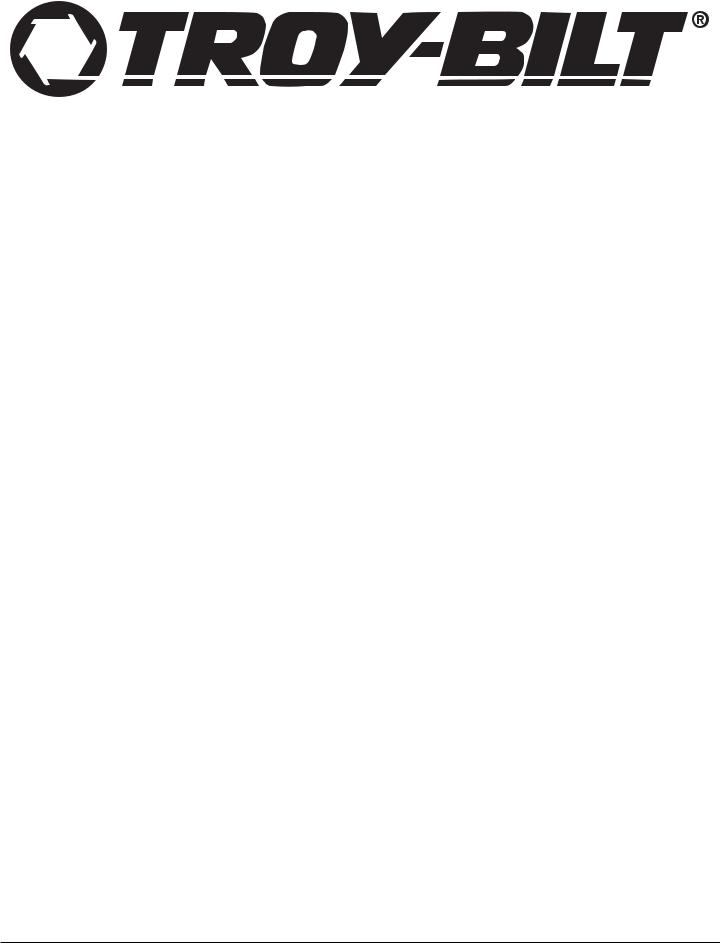
MANUFACTURER’S LIMITED WARRANTY FOR:
The limited warranty set forth below is given by Troy-Bilt LLC (“Troy-Bilt”) with respect with new merchandise purchased and used in the United States, its possessions and territories.
Troy-Bilt warrants this product against defects in material and workmanship for a period of two (2) years commencing on the date of original purchase and will, at its option, repair or replace, free of charge, any part found to be defective in material or workmanship. This limited warranty shall only apply if this product has been operated and maintained in accordance with the Operator’s Manual furnished with the product, and has not been subject to misuse, abuse, commercial use, neglect, accident, improper maintenance, alteration, vandalism, theft, fire, water or damage because of other peril or natural disaster. Damage resulting from the installation or use of any accessory or attachment not approved by Troy-Bilt for use with the product(s) covered by this manual will void your warranty as to any resulting damage.
This warranty is limited to ninety (90) days from the date of original retail purchase for any Troy-Bilt product that is used for rental or commercial purposes, or any other incomeproducing purpose.
HOW TO OBTAIN SERVICE: Warranty service is available, WITH PROOF OF PURCHASE THROUGH YOUR LOCAL AUTHORIZED SERVICE DEALER. To locate the dealer in your area, please check for a listing in the Yellow Pages or contact the Customer Service Department of Troy-Bilt by calling 1- 800-828-5500 or writing to P.O. Box 361131, Cleveland OH 44136-0019 or if in Canada call 1-800-668-1238. No product returned directly to the factory will be accepted unless prior written permission has been extended by the Customer Service Department of Troy-Bilt.
This limited warranty does not provide coverage in the following cases:
A.Tune-ups - Spark Plugs, Carburetor Adjustments, Filters
B.Wear items - Bump Knobs, Outer Spools,Cutting Line, Inner Reels, Starter Pulley,Starter Ropes, Drive Belts
C.Troy-Bilt does not extend any warranty for products sold or exported outside of the United States of America, its possessions and territories, except those sold through Troy-Bilt’s authorized channels of export distribution.
Troy-Bilt reserves the right to change or improve the design of any Troy-Bilt product without assuming any obligation to modify any product previously manufactured.
No implied warranty, including any implied warranty of merchantability or fitness for a particular purpose, applies after the applicable period of express written warranty above as to the parts as identified. No other express warranty or guaranty, whether written or oral, except as mentioned above, given by any person or entity, including a dealer or retailer, with respect to any product shall bind Troy-Bilt. During the period of the Warranty, the exclusive remedy is repair or replacement of the product as set forth above. (Some states do not allow limitations on how long an implied warranty lasts, so the above limitation may not apply to you.)
The provisions as set forth in this Warranty provide the sole and exclusive remedy arising from the sales. Troy-Bilt shall not be liable for incidental or consequential loss or damages including, without limitation, expenses incurred for substitute or replacement lawn care services, for transportation or for related expenses, or for rental expenses to temporarily replace a warranted product.
(Some states do not allow limitations on how long an implied warranty lasts, so the above limitation may not apply to you.)
In no event shall recovery of any kind be greater than the amount of the purchase price of the product sold. Alteration of the safety features of the product shall void this Warranty. You assume the risk and liability for loss, damage, or injury to you and your property and/or to others and their property arising out of the use or misuse or inability to use the product.
This limited warranty shall not extend to anyone other than the original purchaser, original lessee or the person for whom it was purchased as a gift.
How State Law Relates to this Warranty: This warranty gives you specific legal rights, and you may also have other rights which vary from state to state.
To locate your nearest service dealer dial 1-800-828-5500 in the United States or 1-800-668-1238 in Canada.
Troy-Bilt LLC
P.O. Box 361131
Cleveland, OH 44136-0019
16
